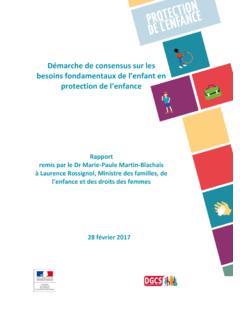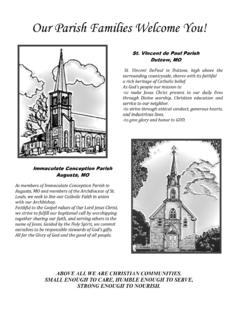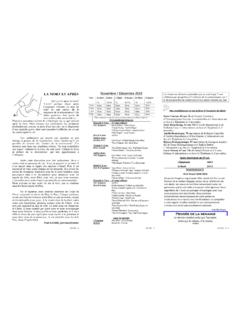Transcription of Developing sustainable food value chains - …
1 Developing sustainable food value chains Guiding principles PRODUCTION AGGREGATION PROCESSING DISTRIBUTION CONSUMPTION. 1 2. [A]. 3. [B]. 4. 5 LOCAL. MARKET. Developing sustainable food value chains Guiding principles David Neven food AND AGRICULTURE ORGANIZATION. OF THE UNITED NATIONS. Rome, 2014. RECOMMENDED CITATION. FAO. 2014. Developing sustainable food value chains Guiding principles. Rome Cover photos (from top). Women work the rice fields in Vietnam and most Developing countries. Lothar Wedekind/IAEA. A worker at the Valdafrique Processing Plant. FAO/Seyllou Diallo Employee canning artichoke hearts at the AgroMantaro processing plant in Jun n, Peru. FAO/David Neven Women buying fish from the wholesaler. FAO/Antonello Proto A little girl eats a freshly-made roti.
2 S. Mojumder/Drik/CIMMYT. The designations employed and the presentation of material in this information product do not imply the expression of any opinion whatsoever on the part of the food and Agriculture Organization of the United Nations (FAO) concerning the legal or development status of any country, territory, city or area or of its authorities, or concerning the delimitation of its frontiers or boundaries. The mention of specific companies or products of manufacturers, whether or not these have been patented, does not imply that these have been endorsed or recommended by FAO in preference to others of a similar nature that are not mentioned. The views expressed in this information product are those of the author(s) and do not necessarily reflect the views or policies of FAO.
3 ISBN 978-92-5-108481-6 (print). E-ISBN 978-92-5-108482-3 (PDF). FAO, 2014. FAO encourages the use, reproduction and dissemination of material in this information product. Except where otherwise indicated, material may be copied, downloaded and printed for private study, research and teaching purposes, or for use in non-commercial products or services, provided that appropriate acknowledgement of FAO as the source and copyright holder is given and that FAO's endorsement of users' views, products or services is not implied in any way. All requests for translation and adaptation rights, and for resale and other commercial use rights should be made via or addressed to FAO information products are available on the FAO website ( ). and can be purchased through Contents Foreword v Acknowledgements vi Executive summary vii Abstract x About the author xi Acronyms xii Chapter 1.
4 Introduction 1. Chapter 2. Concept and framework 5. Defining the concept 6. Related concepts 8. The sustainable food value chain framework 10. Chapter 3. The sustainable food value chain development paradigm 13. Return on assets: farming as a business and development of small and medium-sized agro-enterprises 14. Salary income: creating decent work opportunities 16. Taxes: ecosocial progress 16. food chain fallacies 17. The sustainable food value chain development paradigm: conclusion 20. Chapter 4. Ten principles in sustainable food value chain development 21. Measuring performance of food value chains . sustainability principles 23. Understanding food value chain performance . analytical principles 35. Improving food value chain performance.
5 Design principles 46. Chapter 5. Potential and limitations 59. Chapter 6. Conclusions 63. References 65. Annex Concepts related to the value - chain concept 71. iii Figures 1. A breakdown of the concept of value added 7. 2. The sustainable food - value - chain framework 11. 3. The sustainable food - value - chain development paradigm 15. 4. Principles of sustainable food - value - chain development 23. 5. Sustainability in food - value - chain development 24. 6. Positive feedback loop driving sustained growth 27. 7. Examples of constraints and leverage points in value chains 37. Boxes Illustration of Principle 1: The potato value chain in India 28. Illustration of Principle 2: The pineapple value chain in Ghana 31. Illustration of Principle 3: The beef value chain in Namibia 34.
6 Illustration of Principle 4: The vegetables value chain in the Philippines 38. Illustration of Principle 5: The tea value chain in Kenya 41. Illustration of Principle 6: The rice value chain in Senegal 45. Illustration of Principle 7: The coffee value chain in Central America 49. Illustration of Principle 8: The ndagala value chain in Burundi 51. Illustration of Principle 9: The dairy value chain in Afghanistan 53. Illustration of Principle 10: The salmon value chain in Chile 56. iv Foreword The development of sustainable food value chains can offer important pathways out of poverty for the millions of poor households in Developing countries. food value chains are complex systems. The real causes for their observed underperformance may not always be obvious.
7 Typically, multiple challenges have to be tackled simul- taneously in order to truly break poverty cycles. This in turn implies the need for collaboration among the various stakeholders in a value chain , including farmers, agribusinesses, governments and civil society. Further compounding the challenge, improvements to the value chain must be economically, socially and environmentally sustainable : the so-called triple bottom line of profit, people and planet. Around the world, development practitioners in public, private and non-governmen- tal organizations are constantly designing and implementing innovative solutions to address these challenges. These practitioners facilitate the upgrading of products, technologies, business models, policy environments and so on.
8 Some of these solu- tions fail to have a lasting impact, while others succeed in improving the system at scale and in a sustainable manner. Either way, valuable lessons are learned. In its role as a global knowledge broker aiming to enable the development of inclusive and efficient agricultural and food systems, the food and Agriculture Organization of the United Nations (FAO) has initiated a new set of handbooks to capture and disseminate the lessons learned from these experiences. This handbook is the first in the set and it contributes to the achievement of FAO's Strategic Objective Four: Enable inclusive and efficient agricultural and food systems. It sets out the overall framework and a set of principles to guide sustainable food value chain development in practice.
9 Subsequent handbooks on this core theme will focus on particular aspects of the approach, taking a systems perspective to present both the main challenges and some of the most promising ways to resolve them. It is expected that this new handbook, and the ones which will follow, will facilitate the spread among practitioners of new ideas and knowledge related to the development of sustainable food value chains . If successful, it is hoped that this will lead to greater, faster and more lasting impacts in terms of growth in profitability of agribusiness and farming, creation of decent employment, generation of public revenue, strengthening of the food supply and improvement in the natural environment. Eugenia Serova Director Rural Infrastructure and Agro-Industries Division, FAO, Rome v Acknowledgements This handbook benefited greatly from the contributions of many people.
10 First and foremost, special thanks goes to the team who supported the development of the handbook throughout its entire process: Martin Hilmi (Rural Infrastructure and Agro-Industries Division [AGS], FAO), Giang Duong (AGS, FAO) and Victor Prada (AGS, FAO). Thanks are extended to those who reviewed earlier drafts or contributed insights, illustrations, or definitions. They include: Heiko Bammann (AGS, FAO), Florence Tartanac (AGS, FAO), David Hitchcock (AGS, FAO), Siobhan Kelly (AGS, FAO), Pilar Santacoloma (AGS, FAO), Emilio Hernandez (AGS, FAO), Djibril Drame (AGS, FAO), Eugenia Serova (AGS, FAO), Guy Evers (Investment Centre Division, Africa Service [TCIA], FAO), Claudio Gregorio (Investment Centre Division, Near East, North Africa, Europe, Central and South Asia Service [TCIN], FAO), Gunther Feiler (Investment Centre Division, Technical Cooperation Department [TCID], FAO), Astrid Agostini (TCID, FAO), Luis Dias Pereira (Investment Centre Division, Latin America, the Caribbean, East Asia and the Pacific Service [TCIO], FAO), Lisa Paglietti (TCIA, FAO), Dino Francescutti (TCIO, FAO)

















